
Sir Joshua Reynolds was an English painter, specialising in portraits. John Russell said he was one of the major European painters of the 18th century. He promoted the "Grand Style" in painting which depended on idealization of the imperfect. He was a founder and first president of the Royal Academy of Arts, and was knighted by George III in 1769.

The Royal Academy of Arts (RA) is an art institution based in Burlington House on Piccadilly in London. Founded in 1768, it has a unique position as an independent, privately funded institution led by eminent artists and architects. Its purpose is to promote the creation, enjoyment and appreciation of the visual arts through exhibitions, education and debate.

The Summer Exhibition is an open art exhibition held annually by the Royal Academy in Burlington House, Piccadilly in central London, England, during the months of June, July, and August. The exhibition includes paintings, prints, drawings, sculpture, architectural designs and models, and is the largest and most popular open exhibition in the United Kingdom. It is also "the longest continuously staged exhibition of contemporary art in the world".

Burlington House is a building on Piccadilly in Mayfair, London. It was originally a private Neo-Palladian mansion owned by the Earls of Burlington and was expanded in the mid-19th century after being purchased by the British government. Today, the Royal Academy and five learned societies occupy much of the building.

Coade stone or Lithodipyra or Lithodipra was stoneware that was often described as an artificial stone in the late 18th and early 19th centuries. It was used for moulding neoclassical statues, architectural decorations and garden ornaments of the highest quality that remain virtually weatherproof today.

Congress House is the headquarters of the Trades Union Congress (TUC), a British organisation that represents most of the UK's trade unions. It is also an events venue, Congress Centre.
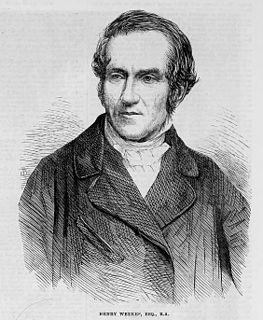
Henry Weekes was an English sculptor, best known for his portraiture. He was among the most successful British sculptors of the mid-Victorian period.
Edward Alfred Briscoe Drury was a British architectural sculptor and artist active in the New Sculpture movement. During a long career Drury created a great number of decorative figures such as busts and statuettes plus larger monuments, war memorials, statues of royalty and architectural pieces. During the opening years of the 20th-century he was among the foremost architectural sculptors active in Britain and in that period created the series of works in central London for which he is perhaps now best known. These include the figures on the Old War Office building in Whitehall, elements of the facade of the Victoria and Albert Museum and four of the colossal statues on Vauxhall Bridge.

Lichfield Court, in Richmond, London, consists of two Grade II listed purpose-built blocks of flats. Designed by Bertram Carter and built in fine Streamline Moderne style, it was completed in 1935.
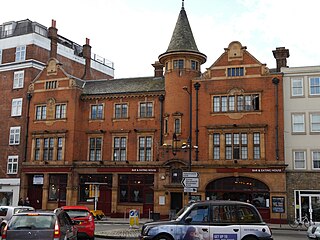
The King's Head is a Grade II listed public house at 4 Fulham High Street, Fulham, London.
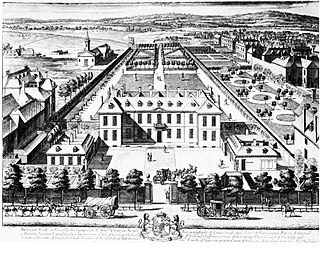
Burlington Gardens is a street in central London, on land that was once part of the Burlington Estate.

New Burlington Street is a street in central London that is on land that was once part of the Burlington Estate. The current architecture of the street bears little resemblance to the original design of the street when first built in the early eighteenth century.
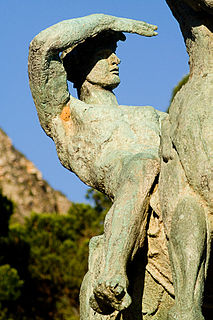
Physical Energy is a bronze equestrian statue by English artist George Frederic Watts. Watts was principally a painter, but also worked on sculptures from the 1870s. Physical Energy was first cast in 1902, two years before his death, and was intended to be Watts's memorial to "unknown worth". Watts said it was a symbol of "that restless physical impulse to seek the still unachieved in the domain of material things". The original plaster maquette is at the Watts Gallery, and there are four full-size bronze casts: one in London, one in Cape Town, one in Harare and one soon to be sited at Watts Gallery - Artists' Village in Compton, Surrey. Other smaller bronze casts were also made after Watts's death.

The statue of the 1st Marquess of Westminster is an outdoor sculpture depicting the owner and developer of the surrounding Grosvenor estate, Robert Grosvenor, 1st Marquess of Westminster. The statue by Jonathan Wylder is located at the corner of Wilton and Grosvenor Crescents, Belgravia, London, England, and was commissioned by Gerald Grosvenor, 6th Duke of Westminster in 1998.
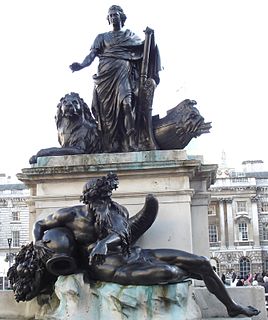
The statue of George III, Somerset House, formally titled George III and the River Thames, is a Grade I listed outdoor bronze sculptural group depicting King George III and Neptune or Father Thames, located in the quadrangle of Somerset House, London, England. The sculptor was John Bacon, and the statue was erected between 1778 and 1789.

A statue of Edward Jenner, the physician, scientist and pioneer of the world's first vaccine, is located in Kensington Gardens in London. A work of the sculptor William Calder Marshall, the bronze was originally unveiled by Albert, Prince Consort in Trafalgar Square on 17 May 1858, before being moved to its present location in 1862. It is a Grade II listed building.
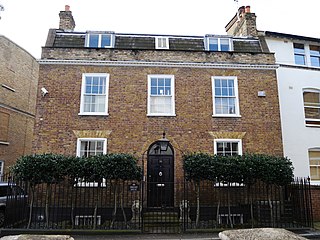
Dwight House is a Grade II listed house at 38 Burlington Road, Fulham, London, built in the late 18th century.
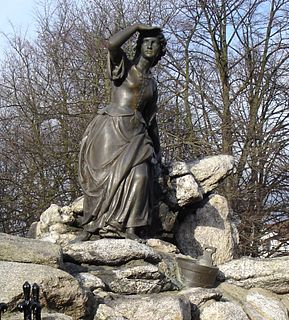
The Matilda Fountain is a Grade II listed statue and drinking fountain opposite 15 Gloucester Gate, Regent's Park, London, built in about 1878.

A statue of Thomas Guy stands in the forecourt of Guy's Hospital in the borough of Southwark in Central London. The statue is Grade II listed.


















